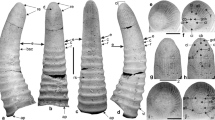Abstract
PRESENT-DAY authorities agree that, within the Mollusca, the chitons (or Polyplacophora) are closely related to the solenogastres (or Aplacophora). An important item influencing this view is the description, by Pruvot1, of the development of seven overlapping, dorsal, plate-like spicules in the metamorphosing larva of the solenogastre, Nematomenia banyulensis. The appearance of these spicules has been considered to be a reminiscence of a chiton-like ancestor and, no doubt, has influenced many authors in coming to the conclusion that the solenogastres are degenerate chitons. Pruvot's description was based on observations on a single larva, but nonetheless the figure he gave of this developmental stage has been widely reproduced in general works.
Similar content being viewed by others
References
Pruvot, G., C.R. Acad. Sci., Paris, 3, 689 (1890).
Baba, K., J. Dept. Agric. Kyusyu Univ., 6, 21 (1938).
Author information
Authors and Affiliations
Rights and permissions
About this article
Cite this article
THOMPSON, T. Development of the Aplacophorous Mollusc Neomenia carinata Tullberg. Nature 184, 122–123 (1959). https://doi.org/10.1038/184122b0
Issue Date:
DOI: https://doi.org/10.1038/184122b0
- Springer Nature Limited




